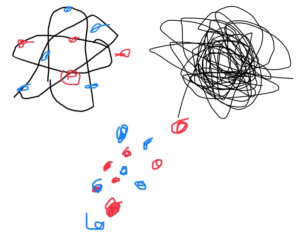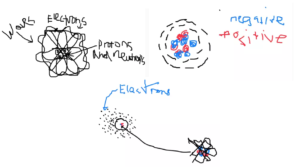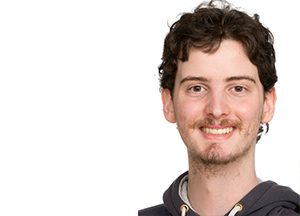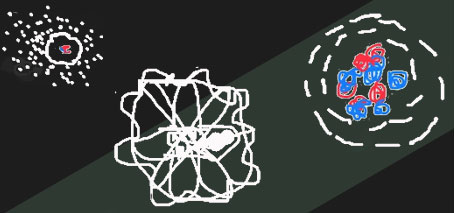
Before and after: At the start of the workshop, primary school students concept of an atom followed ‘cartoon’ style (or ‘basic Rutherford’), scribbly blobs and random dots.
A FLEET Primary School pilot workshop showed primary students can learn and conceptualize quantum physics and are adept at the Mexican wave.
Meanwhile, 155 Hughesdale Primary School students got their first introduction to quantum physics.
The year 5 and 6 students explored the quantum atomic model via role-playing activities, applying this to understand how electricity and resistance work at the quantum level.
“We asked students to participate in a Mexican wave to simulate electron wave-like functions and phonons,” says FLEET outreach coordinator Jason Major. The students then applied that knowledge to construct graphite circuits, with questioning revealing the students had gained some understanding of the new concepts.
“At a qualitative level the students understood and could conceptualise how electricity and resistance works at the quantum level,” says Jason
As far as we know, the pilot lesson is a first, certainly in Australia.
“We are aware of research into teaching primary students about how the atom works at the quantum level. But we think this is the first time anyone has attempted to teach primary students how resistance and electricity works at the quantum level,” says Jason.

Improved understanding: Students’ perception of atoms after the workshop showed electrons as waves, in energy shells, and in an electron cloud.
“We can thank Ant Man for exposing the kids to the concept of “quantum”, where weird stuff happens when things get really really small,” says Monash PhD candidate Bernard Field, who assisted on the day. “But we, of course, provided some… more scientifically grounded quantum concepts on top of this.”
“Hopefully this will make “quantum” seem less mystifying and more approachable to the kids.”
After concepts were explained and explored via the Mexican wave exercise, students’ drawings of atoms suggested they understood electrons have a wave-like behaviour or existed in a cloud surrounding the nucleus and had an indeterminate position.
They could grasp that resistance was electrons losing energy as they flowed through a circuit (as a wave) and that this energy was lost when they interacted with phonons and transferred their energy to the atomic lattice. “This suggests primary students are capable or conceptualising at a qualitative level, the quantum mechanics of electricity and resistance,” says Jason.
The students were also introduced to FLEET research and the challenge of ever-increasing energy consumption of digital technologies. Students were involved in a discussion about ways to help solve this problem and how FLEET is trying to develop novel materials that will conduct electricity without any resistance and reduce the energy consumption of digital technologies.

Outreach participant Bernard Field
Most students began to think critically about this problem with comments during the post-evaluation activities such as, “we need sustainable electronics where electrons don’t lose energy”(or use less energy). At least one student saw the need to have materials that could enable electrons to flow without resistance: “We need to find materials that make electrons go ’round (a circuit) without energy loss.”
Students responses’ to such questions were eye-opening for FLEET staff too:
“When we asked the kids what could be done to reduce the energy demand of ICT, I guess we were fishing for: ‘make devices which conduct electricity better’,” says Bernard Field.
“But the kids came up with many other valid solutions as well. These solutions included behavioural ones like using devices less, infrastructure solutions like making more renewable power, and technological solutions like making devices use less energy in all aspects of their operation. It shows how innovative and aware kids are, that they’re already considering solutions to tomorrow’s problems.”
What’s an atom look like? Before and after…

Outreach participant Kenneth Choo
At the start of the lesson, students’ perceptions of an atom either took on the classic ‘cartoon’ atomic shape, scribbly blobs, or random dots.
Post-workshop, most students’ perceptions of atoms had shifted.
Many students drew atoms with electrons as waves (30%), while some showed those waves in different energy shells (14%), or even drew electron ‘clouds’, where the position and energy of the electron is uncertain (18%).
This suggests that students understood electrons have a wave-like behaviour, and/or existed in a cloud surrounding the nucleus and had an indeterminate position.
Assisting Jason, FLEET/Monash PhD candidates Bernard Field, Kenneth Choo and Enamul Haque also found the exercise rewarding:
“It felt fulfilling to help these children learn about electricity. We approached these topics in a fun and hands-on manner which should be memorable. It’s rewarding to see kids come to a greater appreciation of science. I encourage scientists to find opportunities to reach out to schools, such as within FLEET or in other programs like STEM Professionals in Schools.”

Outreach participant Enamul Haque
FLEET is now seeking other schools to participate in the refinement process of this workshop

